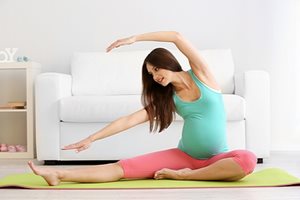Why Active Mums Should Rethink Their Exercise Regime With Pregnancy

Are you someone who enjoys the strenuous, heart pumping rush of high intensity exercise classes, running, cycling, or team sports? If you now find yourself pregnant then you might not be sure what sort of exercise to turn to?
At this time, Pilates is a great option as it helps the body to cope with the changing requirements that will develop during pregnancy. At the same time, Pilates will focus on building strength in the arms and legs for not only the physical ordeal of labour, but also for post-baby recovery.
During pregnancy, vast postural changes will occur including an increase in lordosis (the natural curve in your low back), caused by an increase in the size of your pregnant belly. Often this also goes hand in hand with an increase in kyphosis (the natural curve of your upper back) due to tight pectoral muscles from an increase in breast size.
As well as your spine and postural muscles undergoing these changes, the pelvis can also become quite unstable as a result of the relaxation of ligaments caused by softening hormones including relaxin. These hormones are released in to the body from the placenta to soften and widen the pelvis in preparation for childbirth. These postural changes are not limited to just pregnancy but can continue on after birth as a result of breast feeding, carrying your child and any excessive weight you may still be carrying.
Pilates is a great way to gain awareness of your changing posture and to limit the effect these postural changes have on your body during and after pregnancy.
For many people, incorporating pelvic floor exercises into their routine is not common. However, we can not stress enough the importance of strong pelvic floor awareness and the ability to not only engage the pelvic floor but also release it. Pilates is a great way to improve your ability to engage the pelvic floor as well as the deep abdominal muscles and incorporate this in to breathing patterns that not only help with your labour, but also prevent any issues post pregnancy such as prolapses or incontinence.
Correct breathing patterns learnt through Pilates can provide huge benefits in an active labour situation by decreasing anxiety, improving relaxation and energy levels, and ensuring adequate oxygen supply to the uterine muscles and the baby. Pilates encourages abdominal breathing, and encourages breathing in through your nose and out through your mouth, the same style of breathing that has been found to be most beneficial in a labour setting.
These breathing techniques can also provide a meditative effect. A lot of pregnant women find it helps clear their mind of other life distractions, allowing them to focus on themselves and their body.
To gain the best results from Pilates it is advised to participate in small studio group classes or private sessions where you will be given personalised attention based on your goals and needs.
Author Bio:
Nicole Karl is the Senior Pilates Instructor / Pilates Manager at Melbourne Osteopathy Centre. She is a Level 3 member of the Australian Pilates Method Alliance (APMA). Nicole has gained expertise in chronic conditions, lower back & spinal injuries and disc injuries. She enjoys working closely with other health professionals to help her clients achieve their goals and the best outcomes possible.